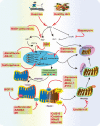Mitochondrial Dysfunction and Oxidative Stress in Alzheimer's Disease
- PMID: 33679375
- PMCID: PMC7930231
- DOI: 10.3389/fnagi.2021.617588
Mitochondrial Dysfunction and Oxidative Stress in Alzheimer's Disease
Abstract
Mitochondria play a pivotal role in bioenergetics and respiratory functions, which are essential for the numerous biochemical processes underpinning cell viability. Mitochondrial morphology changes rapidly in response to external insults and changes in metabolic status via fission and fusion processes (so-called mitochondrial dynamics) that maintain mitochondrial quality and homeostasis. Damaged mitochondria are removed by a process known as mitophagy, which involves their degradation by a specific autophagosomal pathway. Over the last few years, remarkable efforts have been made to investigate the impact on the pathogenesis of Alzheimer's disease (AD) of various forms of mitochondrial dysfunction, such as excessive reactive oxygen species (ROS) production, mitochondrial Ca2+ dyshomeostasis, loss of ATP, and defects in mitochondrial dynamics and transport, and mitophagy. Recent research suggests that restoration of mitochondrial function by physical exercise, an antioxidant diet, or therapeutic approaches can delay the onset and slow the progression of AD. In this review, we focus on recent progress that highlights the crucial role of alterations in mitochondrial function and oxidative stress in the pathogenesis of AD, emphasizing a framework of existing and potential therapeutic approaches.
Keywords: Alzheimer’s disease; fission; fusion; mitochondria; mitophagy; oxidative stress.
Copyright © 2021 Misrani, Tabassum and Yang.
Conflict of interest statement
The authors declare that the research was conducted in the absence of any commercial or financial relationships that could be construed as a potential conflict of interest.
Figures




Similar articles
-
Nuclear Factor-Erythroid 2-Related Factor 2 (Nrf2) and Mitochondrial Dynamics/Mitophagy in Neurological Diseases.Antioxidants (Basel). 2020 Jul 15;9(7):617. doi: 10.3390/antiox9070617. Antioxidants (Basel). 2020. PMID: 32679689 Free PMC article. Review.
-
Mitochondrial biogenesis: pharmacological approaches.Curr Pharm Des. 2014;20(35):5507-9. doi: 10.2174/138161282035140911142118. Curr Pharm Des. 2014. PMID: 24606795
-
Impact of diet and exercise on mitochondrial quality and mitophagy in Alzheimer's disease.Ageing Res Rev. 2025 Jun;108:102734. doi: 10.1016/j.arr.2025.102734. Epub 2025 Mar 20. Ageing Res Rev. 2025. PMID: 40120948 Review.
-
Mitochondrial defects: An emerging theranostic avenue towards Alzheimer's associated dysregulations.Life Sci. 2021 Nov 15;285:119985. doi: 10.1016/j.lfs.2021.119985. Epub 2021 Sep 27. Life Sci. 2021. PMID: 34592237 Review.
-
Defective mitophagy in Alzheimer's disease.Ageing Res Rev. 2020 Dec;64:101191. doi: 10.1016/j.arr.2020.101191. Epub 2020 Oct 3. Ageing Res Rev. 2020. PMID: 33022416 Free PMC article. Review.
Cited by
-
Inhibiting amyloid beta (1-42) peptide-induced mitochondrial dysfunction prevents the degradation of synaptic proteins in the entorhinal cortex.Front Aging Neurosci. 2022 Oct 6;14:960314. doi: 10.3389/fnagi.2022.960314. eCollection 2022. Front Aging Neurosci. 2022. PMID: 36275011 Free PMC article.
-
Potential of Therapeutic Small Molecules in Apoptosis Regulation in the Treatment of Neurodegenerative Diseases: An Updated Review.Molecules. 2022 Oct 25;27(21):7207. doi: 10.3390/molecules27217207. Molecules. 2022. PMID: 36364033 Free PMC article. Review.
-
Pathogenesis of (smoking-related) non-communicable diseases-Evidence for a common underlying pathophysiological pattern.Front Physiol. 2022 Dec 15;13:1037750. doi: 10.3389/fphys.2022.1037750. eCollection 2022. Front Physiol. 2022. PMID: 36589440 Free PMC article. Review.
-
A new model for fatty acid hydroxylase-associated neurodegeneration reveals mitochondrial and autophagy abnormalities.Front Cell Dev Biol. 2022 Dec 14;10:1000553. doi: 10.3389/fcell.2022.1000553. eCollection 2022. Front Cell Dev Biol. 2022. PMID: 36589738 Free PMC article.
-
Antioxidant Therapy in Oxidative Stress-Induced Neurodegenerative Diseases: Role of Nanoparticle-Based Drug Delivery Systems in Clinical Translation.Antioxidants (Basel). 2022 Feb 17;11(2):408. doi: 10.3390/antiox11020408. Antioxidants (Basel). 2022. PMID: 35204290 Free PMC article. Review.
References
Publication types
LinkOut - more resources
Full Text Sources
Other Literature Sources
Miscellaneous

